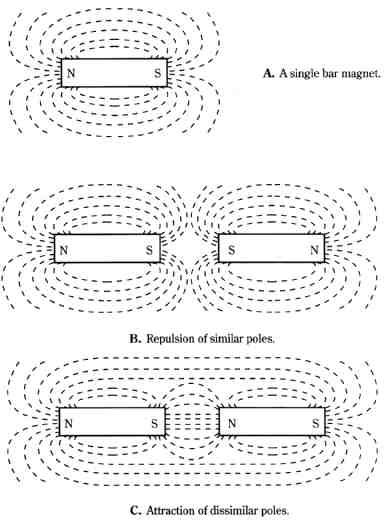AMAZON multi-meters discounts AMAZON oscilloscope discounts
..The general practical aspects of magnets are now well known; the considerable forces of attraction and repulsion evident between the poles of strong magnets naturally suggest the possibilities of motor action. Not only do ferromagnetic materials have force fields available with reasonable shapes, they have permanent magnetization as an added dividend. However, if you did not know otherwise, it would be easy to cite reasons why the magnetization of magnets should be “used up” under certain circumstances.
Magnetic lines of force surrounding bar magnets are shown in FIG. 4. The mag nets behave as if such field lines had the following characteristics:
• Like poles repel; unlike poles attract.
• The forces of attraction and repulsion are the same when pole strengths, distances, and arrangements are the same.
• Pole pairs always exist in a magnet in such a way that one might say that the lines leave from a north pole and enter at a south pole. There are no unipoles in practical magnets.
• Lines of force never cross. In a space subjected to fields from more than one source, a resultant field is produced, having a density and direction deter mined by the directions and strengths of the contributing fields.
• In the case of repulsion, it is more correct to speak of field deflection than of neutralization. In other words, lines of force have their paths altered, but they are not destroyed.
• The lines of force surrounding a magnet mutually repel one another.
• Lines of force have been likened to rubber bands in that they seek the shortest path. A somewhat better statement would be that they seek the easiest magnetic path.
• Forces arising from magnetism obey the inverse square law.
- - -
1. Benjamin Franklin actually made an electrostatic motor! It produced rotation from the stored electrostatic energy in a Leyden jar. A modernized version of this machine developed one-tenth horsepower when powered from a 30,000-volt electrostatic generator. Electrostatic motors must also consume current to produce useful torque. The situation remains, as in Franklin’s day, tantalizingly suggestive, but generally impractical.
- - -
Interestingly, there have been reports of discoveries that the magnetic field has a particle nature. The search for the elusive magnetic monopole has apparently been rewarded with success. Although this can have tremendous ramifications for motor technology, the nature of practical implementations is not yet discernible.

FIG. 4 The field patterns associated with magnetic lines of force.
A. A single bar magnet.
B. Repulsion of similar poles.
C. Attraction of dissimilar poles.
All magnetic action is believed to stem from the effect of charges in motion. Most often involved is the orbital and spin motion of electrons in atoms. In most atoms, the electrons are paired off, so no external magnetic effect occurs. But in the atoms of ferromagnetic materials such as iron, nickel, and cobalt, there is a net magnetic moment due to the spin of electrons not paired with other electrons having counterspins. In a sense, there are no “natural magnets”—magnetism is the result of charges in motion. (Remember the “forces” produced by a gyroscope in which gravitation like fields result from the rotation of a mass.)